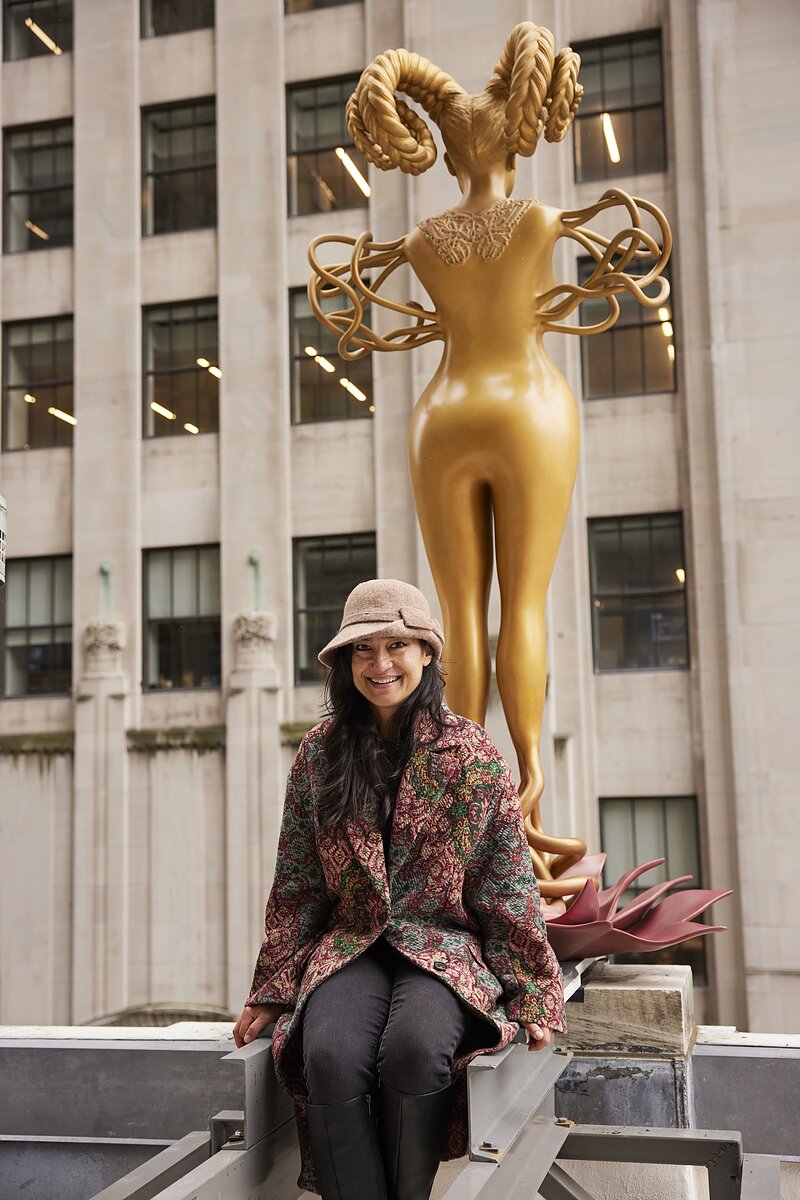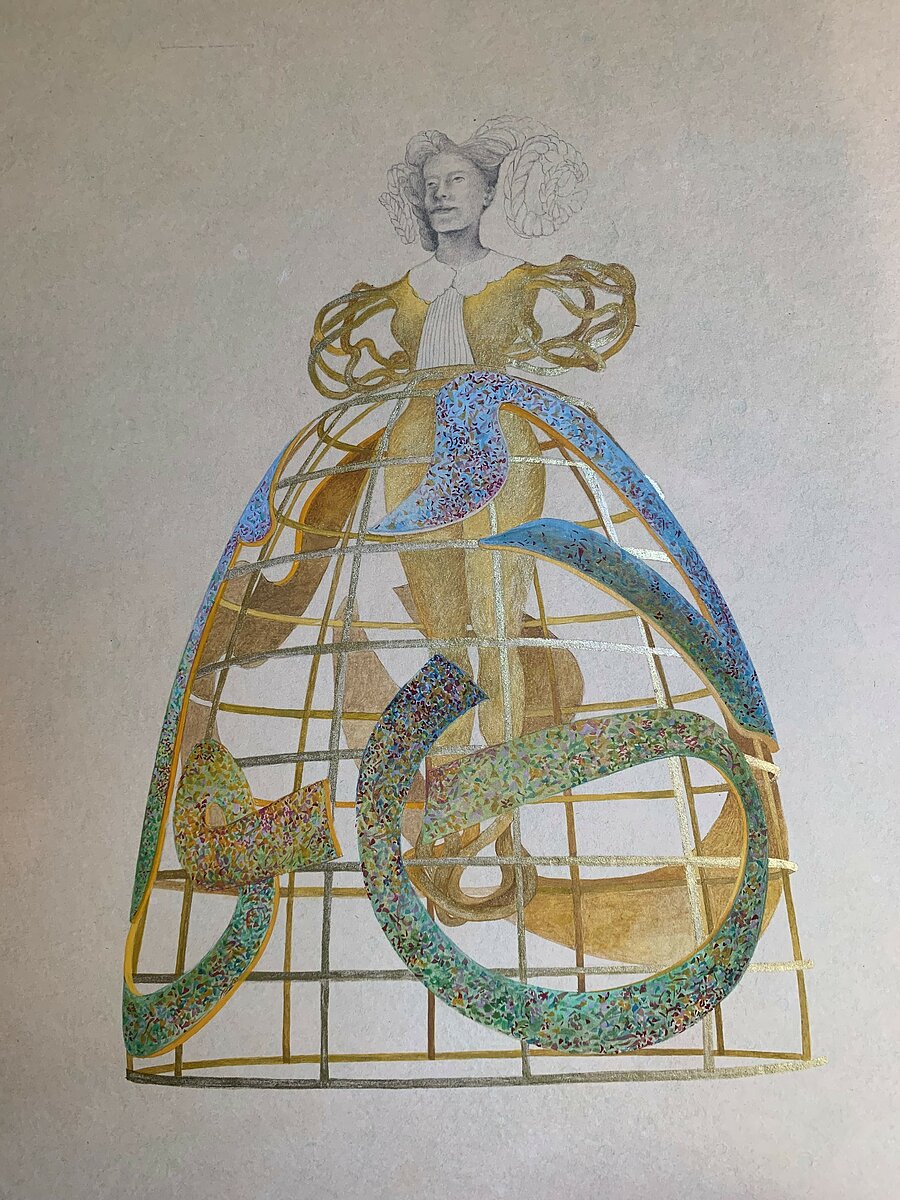Shahzia Sikander On Using Art to Inspire Possibilities
The word “havah” crosses many languages and borders and bears as many meanings. In Urdu, havah translates to “atmosphere.” In Hindi, it means “air.” In Hebrew and Arabic, it can mean “to breathe” or “to give life” and is also the name for the Biblical Eve. This cross-pollinated, bountiful array of significance is celebrated in full and given renewed urgency with Pakistani American artist Shahzia Sikander’s public art installation, Havah…to breathe, air, life (2023).
On view at Madison Square Park and the nearby Supreme Courthouse of New York, the installation features two golden statues of women, each mythological in their grandeur and symbolism. The first, titled Witness (2023), stands at 18 feet tall. Blooming from her waist like a bell is a hoop skirt embellished with serpentine mosaic flourishes that spell “havah” in Arabic.
Across the street and above the bustling throng is Sikander’s second figure, NOW (2023), who sits alongside nine stone figures of men who have administered and pondered law throughout history: Confucius, Moses, Zoroaster. As the lone female sentinel of justice guarding the courthouse, NOW beckons us to consider who our laws are meant to protect, particularly as rights protecting bodily autonomy for women and the transgender community are being stripped away daily.
In addition to these physical figures is an AR experience, Apparition (2023), as well as Sikander’s 2020 animated film, Reckoning. The cumulative effect of these works in concert is, as the title affirms, restorative. For many of us, the events of recent years have shaken our faith in the world, making us question where we go from here. Havah…to breathe, air, life reminds us of the first critical steps.
Best known for her work contemporizing Indo-Persian miniature paintings exploring colonialism, migration, and language, Sikander spoke with The Amp’s editor, Shannon Lee, via an email exchange about the Madison Square Park Commission which is the MacArthur grant recipient’s first-ever foray into sculptural work.
Shahzia Sikander: The sculpture, Witness, at 18 feet high, rises in Madison Square Park near the entrance at 25th street and Fifth Avenue. Taking inspiration from the translucency and defined architecture of the stained glass ceiling dome of the nearby Appellate courtroom, I thought to reimagine the dome as a house, a space demarcating a site of renewal.
The inverted dome transformed into the metal frame (hoopskirt) of Witness, surrounding the body and functioning as its armor and support. The longitudinal and latitudinal lines of the ceiling dome are echoed in the armature of the skirt. Mapped on the surface of this metal structure is the word “havah” which means air, atmosphere, or to breathe. It also translates to the name Eve. The designed letters are made with ungrouted glass tesserae.
In Witness, the feminine form is buoyant, supported by the skirt at the waist, rising upward, breaking through the symbolic glass ceiling.
NOW, an eight-foot sculpture on the roof of the courthouse, uses the same feminine form as in Witness, but the body emerges out of a lotus. The lotus, with its plethora of meanings and associated abstract ideas, symbolizes a deeper truth beyond its form, alluding to perception as illusion. Popular in the imagery of many cultures, it also expresses intangible ideas of humility, awakening, and clarity. The invisible roots of the lotus that lie below the surface of the water are echoed in the roots of the feminine figure.
The figure’s hair is braided into spiraling horns, to mimic the movement of the arms in an expression of the figure’s sovereignty and autonomy. Both sculptures wear decorative jabots at the neckline, referring to the accessory popularized by United States Supreme Court associate justice Ruth Bader Ginsburg and the feminization of the black judicial robes traditionally worn by male justices of the Court.
SS: My proposal developed through conversations with the Madison Square Park Conservancy as well as with the fabricators UAP. I had previously undertaken public art works as video projections of moving images accompanied by music, but never site-specific large scale sculpture. Positioning the work in the park and on the rooftop yielded additional challenges of engineering the interactivity of the works with their public interface.
The conversation extended to creating an AR lens experience to bring to the ground virtually the sculpture installed on the courthouse roof plinth. These conversations with the Madison Square Park Conservancy and realized works would unite the courthouse and park and probe who historically is represented and who symbolically and actually wields power in the justice system.
SS: Society’s perception of the tensions between women and power and how erasure is enacted by the social forces that shape women’s lives constructs what femininity means to me. The feminine as the monstrous, the abject, the fecund, the immense, and the vulnerable have permeated literary history. Intimacy, selfhood, valor, resistance, and femininity’s intersections with race and war are indicators of the fear that lurks when boundaries melt.
The feminine at the center of the two sculptures, NOW and Witness is amorphous, like the self, and refuses to be fixed and grounded. Part of the feminine form loops out and into itself, in place of arms and feet, offering a non-fixed idea to the notion of the body. She is self-rooted and a form of resilience, alluding to the unflagging spirit of women. Despite the courthouse having had allegorical female figures, no figures of female judges or justices had previously existed outside. In her feminine form, she also embodies a fierce form of resistance in a gendered space that has historically been asserted and eclipsed by patriarchal representation.
NOW was needed now, at a time when women’s dignity, equality, and freedom were under siege after the U.S. Supreme Court in June overturned the constitutional right to abortion. NOW and Witness urge a reimagining of the feminine not simply as Lady Justice with her scale, but of the female as an active agency, a thinker, a participant as well as a witness to the patriarchal-rooted history of art and law.
SS: I have been making animated videos for more than twenty years, since 2001. My work in animation happened naturally out of working with literal, physical layers of paper in drawings and working on large scale murals in the late 1990s. Presence of space, velocity, magnitude, and direction inherent in the process of drawing are organically enriched through animation, music, and now sculpture.
In my works, movement is critical, and becomes both literal and symbolic such as the crossovers between representation and abstraction, text and image, glass and light, digital and hand, mosaic and animation, geometry and bodies, male and female. There are no binaries. It is the in-between space that is fecund. It suggests the unknown, the untranslatable. For me this idea of mystery is a guiding principle – a generative project. I see it as a resistance to the expected. It is effective in the animations, where the score aids a narrative and movement in time.
Some of the animations, like SpiNN (2003), Disruption as Rapture (2016), Reckoning (2020), The Last Post (2010), Empire follows Art: States of Agitation (2009), and Parallax (2013), allude to the interstices, the transitory, the mythos of the migrant and the citizen, the colonized, women and power, the artist, all those that are caught between worlds, artistic vocabularies, cultures, practices and histories.
Art and juridical norms’ perpetual reevaluations and re-interpretations in the world embody a dynamic that is alive and tethered to its present moment. Such a spirit also exists in and is spurred by animation.
I like to believe that the function of art is to allow multiple meanings and possibilities, to open up space for a more just world. How we experience art, how we respond to it, and how we interpret it is a premise that is open-ended. As an artist, my intent is to create something wondrous and with many possible associations—something that can generate thought and produce difference.



